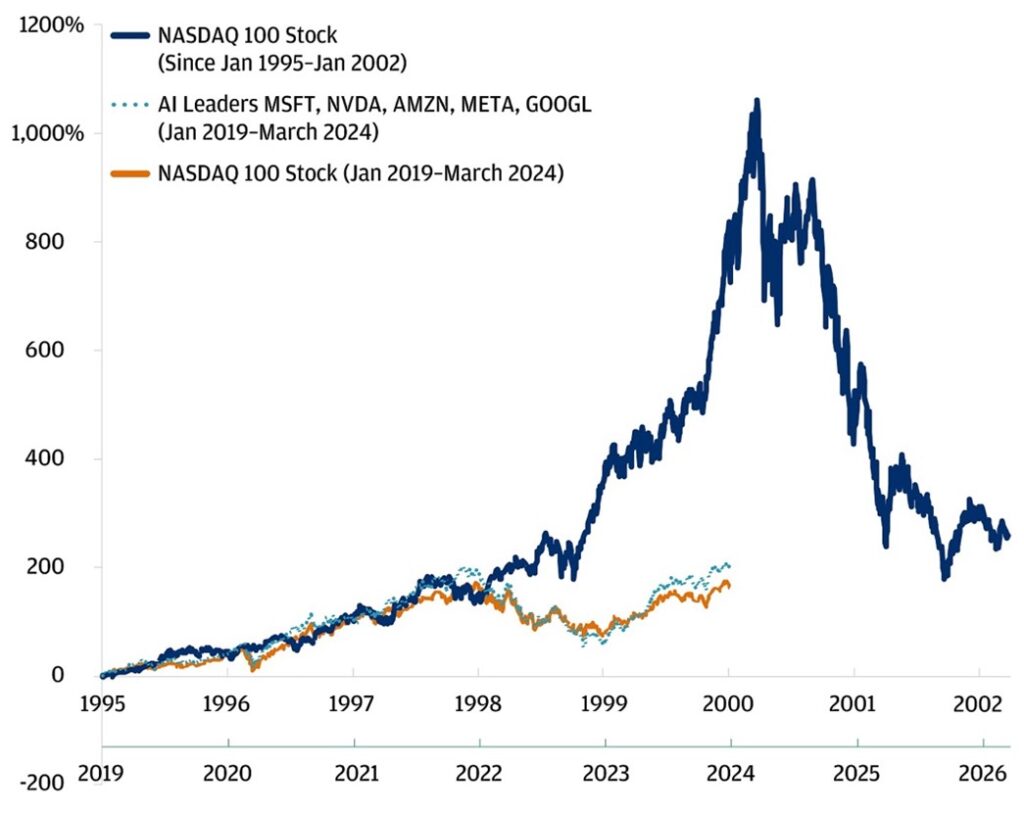There is no doubt that artificial intelligence (AI) has become a generational investment opportunity.
Just look at some of the year-to-date gains of some of the biggest AI-related stocks trading on the Nasdaq exchange:
- Nvidia Corp. (NVDA) — 145%.
- Alphabet Inc. (GOOGL) — 31%.
- Meta Platforms (META) — 33%.
- Advanced Micro Devices (AMD) — 15%.
Compared to the YTD return of the S&P 500 (+18%) — those gains are even more impressive.
The reason for this boom in AI-related stocks is simple. Since the release of OpenAI’s ChatGPT AI model to the general public in 2022, hundreds (if not thousands) of companies have been looking for an edge in this innovative and lucrative space.
And that’s created massive opportunity as the market expands:
In 2022, the global AI market was valued at $124.8 billion. By 2030, the market is expected to reach $826.7 billion — a 562% expansion in less than a decade!
AI is creating a once-in-a-generation investment opportunity. So much so that the Blackrock Investment Institute said transformation related to AI is equivalent to the industrial revolution.
While the long-term potential of AI-related stocks is strong, there are some dents in the armor for the short term.
AI Stocks Have a Valuation Problem
The growing optimism in AI stocks presents a fundamental issue.
Faster-than-average growth in revenue is pushing valuation metrics, like price to earnings, to sky-high levels. Just look at AI stalwart Nvidia Corp.:
On May 22, 2024, NVDA was trading at its lowest P/E ratio of 2024 (55.6). This week, that ratio jumped 35% to 75.
For reference, that’s twice the average of the semiconductor manufacturing industry (37).
A similar AI-related stock, Advanced Micro Devices Inc. (AMD), is currently trading with a P/E ratio of 263 — 3.5X that of NVDA and 7X the industry average.
This means AMD’s price is high relative to its earnings and suggests the stock is way overvalued — investors have to pay more to invest in the stock.
Now, the saving grace here is that P/E ratios and stock prices have not elevated to the level of the dot-com bubble that burst in 2000:
AI Stocks Not as Frothy as Dot-Com Stocks

The chart above compares the Nasdaq 100 Index during the dot-com bubble (blue line) and presently (orange line). It also adds to the performance of AI leaders such as NVDA, GOOGL, AMZN, META and MSFT.
From 1995 to 2000, the Nasdaq 100 gained more than 1,000%. The current performance of both the index and AI leaders is nowhere close to that.
AI stocks may be a bit frothy now, but this is certainly not 2000.
AI Isn’t the Only Game in Town
It’s easy to get caught up in the hype surrounding AI.
To be clear, this is a transformative investing opportunity in the long term.
But, for all its potential, the tech surrounding AI is still very much in its “pregame” phase. I don’t think we have even scratched the surface in terms of AI-related hardware and software.
The high valuations of these stocks are likely to force some pause in the sector.
I mention this now in part because our chief investment strategist, Adam O’Dell, is rolling out his Wealth Multiplier Summit next week. As part of that summit, he’s put together a special report of AI stocks to avoid now.
Add your name to the guest list now and sign up for our text alerts … within moments, you’ll receive that special report as a bonus for signing up early. (You can opt out of these alerts at any time.)
Then, mark your calendar for Tuesday, July 23, at 1 p.m. ET…
That’s when Adam will provide details on his new portfolio — which leverages the Green Zone Power Ratings system in a way never done before and has the power to produce a 157,000% return in less than 25 years.
Click here to make sure you don’t miss his Wealth Multiplier Summit now.
Until next time…
Safe trading,

Matt Clark, CMSA®
Chief Research Analyst, Money & Markets





